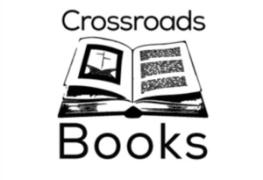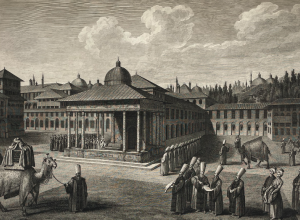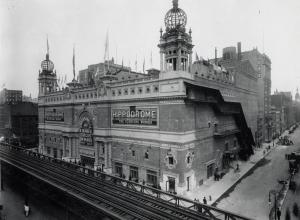Bright Young Librarians: Anthony Tedeschi
For almost two years now, we have been profiling young antiquarian booksellers in our "Bright Young Things" series here on the blog. Today, we launch an expanded definition of "Bright Young Things" to include the next generation of special collections librarians. We begin with Anthony Tedeschi, Deputy Curator of Special Collections at the University of Melbourne in Australia. Tedeschi, an American, began his career at the Lilly Library, then continued as a rare book librarian with Dunedin Public Libraries in New Zealand. He recently accepted a new position with the University of Melbourne and moved to Australia earlier this year:
How did you get started in rare books?
It was in 2002. I was a first year graduate library science student at Indiana University. I entered the program with the intentions of becoming a map librarian, having studied geography and history as an undergraduate at Rutgers University. A friend at Indiana suggested I might be interested in 'History of the Book: From Antiquity to 1450', one of the rare books courses taught by Joel Silver at the Lilly Library, and so I enrolled. The second or third session, Joel wheeled in a trolley of books, one of which was an illuminated Book of Hours. It was the first medieval manuscript I had seen that was not under glass and locked in a display case. I was hooked from the moment I turned the first leaf. That was where I closed the door on map librarianship and began down the path towards a career working with rare books, which, of course, includes antiquarian maps and atlases, so my undergrad education remained nicely relevant despite the change in focus. Two years later I was fortunate enough to land a full-time position at the Lilly. Could not have asked for a better place to begin my career.
What is your role at your institution; what do you specialize in as a librarian?
As deputy curator, my primary role is to assist the curator in the day-to-day operations of the department and share curatorial responsibility for a collection of approximately 250,000 volumes. The position offers a good deal of scope, from collection development and outreach, to selecting items for digitization and cataloguing. Plans are afoot to establish a greater online presence for the collections through social media, which is something I'm really looking forward to overseeing.
I have to agree with Gabe Konrad's response from your Bright Young Booksellers series: 'Specialize is a strong word'. There is always something new to learn in this field, which is one of the things I love about it, and working with diverse materials (from medieval and Islamic manuscripts to modern Australian artists' books) means that I've tried not to become too focused on one particular aspect. I would say, however, that my area of greatest knowledge is in British and Continental books from the late medieval period through to the early nineteenth century, with specific interests in provenance evidence, early printed books, and the history of the book in Britain up to the private presses established during the Interwar Period (1919-1939). I've recently been reading up on the history of the book in Australia (for obvious reasons!) with a particular focus on the vibrant nineteenth-century Melbourne book trade.
Favorite rare book / ephemera that you've handled?
Impossible to pick just one! With each institution for which I've worked comes a particular set of favorite books, so perhaps a selection is allowable? At the Lilly, I would say Abraham Lincoln's law book, the Shakespeare First Folio, and the Gutenberg New Testament (a dream triumvirate). During my time with Dunedin City Library, it would be any of the examples of early printing in the Maori language and a copy of Richard Knolles's The Turkish History (London, 1687 ed.) inscribed by Samuel Pepys. I am still exploring the Melbourne collections, but at this point a favorite book has to be the library's copy of Richard Cosin's An Apologie for Sundrie Proceedings by Iurisdiction Ecclesiasticall (London, 1593), not for its subject matter, but because it is signed by William Juxon, Archbishop of Canterbury. Juxon, when Bishop of London, attended Charles I on the scaffold and administered last rites before the king's execution. Did I mention my interest in provenance?
What do you personally collect?
I don't collect, really. The odd volume of literature and occasional book about books find their way to my shelves, but this is in no way a concentrated effort to build a collection, just leisure reading. I have, though, considered collecting private press prospectuses, which is something I might yet take up.
What excites you about rare book librarianship?
Besides being able to exercise my grey cells on a weekly basis, the chance to work with a variety of rare books and manuscripts never ceases to thrill me. I still get the same charge now that I had when I handled that Book of Hours a dozen years ago, which is a feeling I doubt will ever dissipate, and I've had the opportunity to meet some really great people passionate about books, be they fellow curators, librarians, members of the trade, or collectors. It's also a real sense of satisfaction that comes with being able to share that excitement and passion with students or a visiting group from outside the university, and get them thinking about the importance of books as physical objects beyond the text. Few things say 'job well done' like receiving a thank you card signed by a group of visiting high school students, complete with a decorated initial and snail in imitation of one of the medieval manuscripts they were shown.
Thoughts on the future of special collections / rare book librarianship?
Part of my answer can apply to the above question, since this is a rather exciting time to be working in special collections. Much like the antiquarian book trade, special collections libraries are in a period of transition. There is a shift from a focus on collection development, though this remains an integral part of the job, to one of greater access and outreach. More importantly, this is being done by going where users are, e.g. Facebook, Flickr, Twitter, &c. I think this is key to the long term survivability and viability of special collections. The Web not only offers special collections the means to promote their materials--materials that are often what differentiates one library from another and are therefore increasingly important as general resources homogenize online--but also provides a way to remove the veil of elitism (real or imagined) that so often accompanies the term 'rare books' and reach a far wider audience than ever before. As David Pearson noted in his 2013 Foxcroft Lecture, 'It's the public and the politicians who they vote into office and who ultimately fund libraries ... who need to be converted at least as much as the academy'. The more people that become aware of the existence and importance of special collections, the greater the chance, I think, of ensuring a long and positive future, but it will take those presently employed in the field to really push the agenda. You don't have to search hard to see this is happening, so I am certainly optimistic.
Any upcoming exhibitions at your library?
Now that the most recent exhibition ('Libri: Six Centuries of Italian Books') has finished, the gallery space is closed for the rest of 2013 and into 2014 for expansion and refurbishment, so no exhibitions on the immediate horizon. The first exhibition slated for the new space is called 'Radicals, Slayers, and Villains', which draws from the Special Collections Print Collection of over 8,000 prints. The exhibition focuses on controversial figures from history that have challenged the status-quo and helped shape our world, and includes prints by such seminal artists as Dürer, Goya and Rembrandt. There will also be a major exhibition next year on the eighteenth-century Italian artist Giovanni Battista Piranesi hosted by the State Library of Victoria, to which Melbourne Special Collections is lending a number of bound volumes and single prints. Expect updates by listserv, blog, and Twitter feed!

















